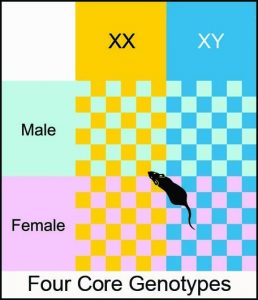The Arnold lab studies biological factors that make males and females different. Many diseases affect the two sexes differently, but the factors that cause the sex differences are poorly understood. Because one sex is often protected from a disease, it makes sense to identify the mechanisms underlying the sex difference as one strategy to find factors that are protective. These factors might be targets for novel therapies.
Most sex differences in physiology and disease are caused by sex hormones coming from the testes or ovaries. We have found, however, that some sex differences also are caused by genes on the sex chromosomes that act outside of the gonads. We are interested in constructing a general theory of sex determination and sexual differentiation that applies to any tissue.
We have used several animal models that offer significant advantages for understanding the factors that cause sex bias in physiology. One is the Four Core Genotypes model, in which the type of the gonad of the animal (testes or ovaries) is not related to its complement of sex chromosomes (XX or XY). This model allows comparing mice that have different sex chromosomes but the same type of gonad, to find traits that are influenced by the complement of sex chromosomes.
Two videos introduce the Four Core Genotypes model, and describe a strategy for studying sex chromosome effects on disease phenotypes in mice.








